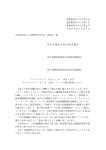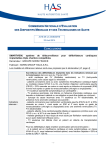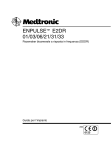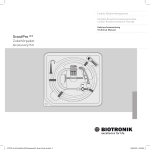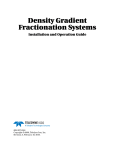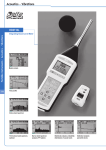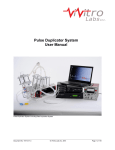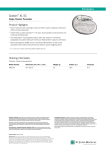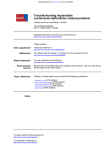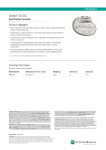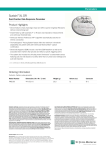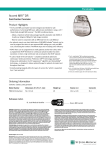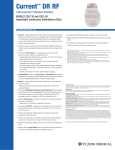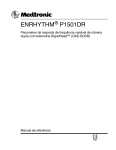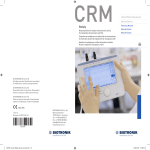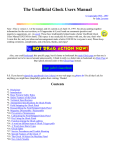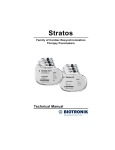Download Victory on demand, time and time again
Transcript
Victory on demand, time and time again Victory ® Pacemaker Family Cardiac Rhythm Management Division 15900 Valley View Court Sylmar, CA 91342 USA 1 888 SJM-CRMD 818 362-6822 818 362-7182 Fax St. Jude Medical AB Veddestavägen 19 SE-175 84 Järfälla SWEDEN +46 8 474 4000 +46 8 760 9542 Fax www.sjm.com Ordering No. N0738 Printed in USA 120 51.5 Consult the User’s Manual for information on indications, contraindications, warnings and precautions Unless otherwise noted, ® or ™ indicates that the name is a trademark of, or licensed to, St. Jude Medical, or one of its subsidiaries. © 2005 St. Jude Medical Cardiac Rhythm Management Division. All rights reserved. Pocket Sales Guide For SJM Personnel Only Table of Contents Introduction Victory® Pacemaker Family This guide is intended to be used as a quick reference tool that you can easily access. The information is intended to help you answer common questions and address objections. Please refer to the product and competitive overview document on my.sjm.com for more comprehensive information Introduction Key Messages and Benefits Victory® Pacemaker Overview Competitive Overview Medtronic Guidant Biotronik ELA Competitive Key Selling Points Medtronic Guidant Biotronik ELA Victory® Device Questions and Answers St. Jude Medical® Device Comparison Charts Competitive Device Comparison Charts References 2 2 3 5 5 10 11 12 12 12 15 16 16 17 20 24 36 Key Messages and Benefits The Victory® pacemaker’s ability to measure thresholds and intrinsic events out-of-clinic enables the physician to save clinic time. This in combination with all of the features from the fully-equipped Identity® ADx pacemaker, as well as the unbeaten longevity of St. Jude Medical pacemakers, will enable St. Jude Medical to define a new “state-of-the-art” for pacemakers. • Less Unnecessary Ventricular Pacing: St. Jude Medical demonstrated in the DAVID (Dual-Chamber And VVI Implantable Defibrillator) study that excessive ventricular pacing may contribute to heart failure in some patients. The Ventricular Intrinsic Preference (VIP™) algorithm adds enhanced flexibility to years of clinical experience with AutoIntrinsic Conduction Search technology to encourage the patient’s intrinsic ventricular conduction to prevail. • Less Time at Follow-Up: Upon interrogation, the Victory® device displays the last measured sense and capture threshold (ventricular only) results obtained automatically within the last 24 hours. The results are displayed with follow-up SEGMs for quick visual validation of the test results. If the clinician chooses to perform additional tests during an in-clinic visit, we have added preset test values to facilitate prompt testing. The addition of this time-saving feature allows for more quality time with patients and less time maneuvering through the programmer screens. The FastPath® Summary Screen allows the clinician flexibility with multiple follow-up options. Caution: It is illegal to promote unapproved devices or features, or make unapproved claims about medical devices. This material is intended exclusively to provide information and training to St. Jude Medical personnel, agents, representatives, and distributors, and, as such, is not to be given, distributed, provided, or discussed with customers or any third parties. • More Time Over the Life of the Device: Features that potentially could extend longevity are Ventricular Intrinsic Preference, Advanced Hysteresis, Auto Rest Rate and the Ventricular AutoCapture™ algorithm. They may also reduce cost and patient stress by reducing pacemaker replacements. 2 Victory® Pacemaker Overview The Victory® DR pacemaker incorporates the most advanced bradycardia management tools on the market into one small package that includes the following new features: • Ventricular Intrinsic Preference (VIP™) technology, a new, refined AICS algorithm designed to reduce unnecessary ventricular pacing • Device-dictated intrinsic measurements (both P and R waves) and diagnostic trends • Lead Monitoring and Auto Polarity Switch • Ventricular Rate during AMS Histogram • Separate programmable Max AF Suppression Rate • Ventricular AutoCapture™ pacing system enhancements • Pre-set test values to speed in-clinic testing • Optimized shipped setting to speed implant set-up • Follow-up EGMs for intrinsic monitoring and ventricular AutoCapture™ pacing system Victory® DR vs. Insignia® Ultra DR vs. EnPulse® DR Pacemaker Victory® DR 5816 XL DR 5810 DR Insignia® Ultra 1291 1290 EnPulse® E2DR01 E2DR21 Ventricular Intrinsic Preference (VIP™) technology ✓ AV Search Hysteresis Search AV+ Auto P- and R-Wave Measurements/Trend ✓ ✓ ✓ Lead Monitor and Trends ✓ ✓ ✓ Follow-Up EGM ✓ V. Response during AMS Histogram ✓ ✓ ✓ Feature or Therapy Diagnostics and Follow-up Victory® DR vs. EnRhythm® DR vs. EnPulse® DR Pacemaker Victory® DR 5816 XL DR 5810 DR EnRhythm® DR P1501DR EnPulse® E2DR01 E2DR21 Ventricular Intrinsic Preference (VIP™) technology ✓ Managed Ventricular Pacing (MVP) Search AV+ Auto P- and R-Wave Measurements/Trend ✓ ✓ ✓ Feature or Therapy Diagnostics and Follow-up Lead Monitor and Trends ✓ Follow-Up EGM ✓ V. Response during AMS Histogram ✓ ✓ ✓ ✓ Victory® DR vs. Philos® II DR vs. Symphony® DR Pacemaker Victory® DR 5816 XL DR 5810 DR Philos® II DR 341 826 Symphony® DR 2550 Ventricular Intrinsic Preference (VIP™) technology ✓ AV Hysteresis DDD/AMC Mode Auto P- and R-Wave Measurements/Trend ✓ ✓ ✓ Lead Monitor and Trends ✓ ✓ Follow-Up EGM ✓ V. Response during AMS Histogram ✓ Feature or Therapy Diagnostics and Follow-up 3 ✓ 4 ✓ Competitive Overview Medtronic EnRhythm® Pacemaker, Model P1501DR Medtronic’s position: New devices offer MVP™ pacing mode to automatically minimize unnecessary right-ventricular pacing. In addition to minimizing right-ventricular pacing, the new EnRhythm® pacemaker has reactive anti-tachycardia pacing, which continually searches for new opportunities to restore a patient's normal sinus rhythm during long atrial tachycardia episodes. It also offers enhanced diagnostic features, especially for patients who may have additional rhythm problems in the upper chambers of the heart, as well as improved longevity. EnRhythm® Pacemaker Key Features Tachyarrhythmia Therapy Algorithms • Antitachycardia pacing (ATP) therapy • Reactive ATP Tachyarrhythmia Prevention Algorithms • Atrial Preference Pacing • Atrial Rate Stabilization • Post Mode Switch Overdrive Pacing Miscellaneous Key Algorithms • Auto-Adjusting Sensitivity • MVP™ (Managed Ventricular Pacing) • Ventricular Rate Stabilization Diagnostics • Cardiac Compass trends • Episode data and EGM storage >16 minutes • ATP isn’t clinically proven. Several studies, including the Medtronic AT500™ Device Verification study1 (325 patients, p < 0.89; ATTEST2, 370 patients, p < 0.25 and ASPECT3, 288 patients) demonstrated no significant difference in the mean number or frequency of AT episodes or AT burden when comparing ATP in the On group versus the Off group. • The ATTEST study2 demonstrated an increase in AF Burden! • 71% of the patients had an increase in recurrent AT after the use of PMOP4! • The MVP™ algorithm allows two out of four beats to be non-supported in the ventricle prior to switching back to DDD. Results of the MVP™ pilot study show your current AICS algorithm is very competitive: 96.1% of AP-VS intervals recorded were < 350 ms (within AICS range)5 90% of ventricular rates < 90 bpm (within AICS range)5 Symptomatic patients, missed ventricular beats, mitral valve regurge and retrograde conduction my not be the therapy your physicians are looking for. Keep in mind the studies demonstrated > 40% RV pacing increases risk! In patients with intact sinus conduction, right ventricular (RV) pacing > 40% leads to an increase in death and heart failure hospitalization6. In patients with sinus node dysfunction, right ventricular (RV) pacing <40% resulted in measurably less risk of HF hospitalization7. If your patient is symptomatic with the MVP™ feature, you have no other option! EnRhythm® Pacemaker Opportunities and Weaknesses • Bipolar lead required. Size and Shape Pacemakers • Pre-arrhythmia SEGMs impact longevity by approximately 33% or by four months per year (based on device modeling with 50% atrial pacing and 5% ventricular pacing). Note: The Pre-Arrhythmia EGM feature does not apply to AT/AF Episodes. The device stores up to five seconds of EGM prior to AT/AF detection, regardless of the pre-arrhythmia settings. 5 Dimensions (mm) Mass (gm) Volume (cc) Longevity* (years) Victory® DR 5810 Victory® XL DR 5816 EnRhythm® P1501DR 43 (h) x 44 (l) x 6 (t) 18 gm 8 cc 6.2 years 44 x 52 x 6 23.5 g 11 cc 11.0 years 45 x 51 x 8 21 gm 13 cc 10.5 years *2.5 V (A & V), 500 Ω, 60 ppm, 100% DDD pacing 6 (internal comparison) Medtronic EnPulse® Pacemaker, Model E2DR01 Medtronic’s position: The world’s first fully automatic pacemaker designed to optimize therapy and simplify care. As the first-ever completely automatic pacemaker, the EnPulse® device offers exclusive features that make it sophisticated yet simple to use. It performs a wide range of diagnostic tests on a regular basis, without clinician intervention. This allows more time to focus on the patient, less time on the device. EnPulse® Pacemaker Key Features Tachyarrhythmia Prevention Algorithms • Post-Mode Switch Overdrive Pacing • Non-Competitive Atrial Pacing Miscellaneous Key Algorithms • Lead Monitor • Automatic Polarity Confirmation • Atrial Capture Management • Ventricular Capture Management • Sensing Assurance • Search AV+ • Ventricular Response Pacing • Kappa had an evoked response undersensing issue which resulted in high-output mode, therefore Ventricular Capture Management has been modified in the EnPulse® device. Time will tell if the algorithm modification works and if the clinicians/physicians will give it a try. • Auto-sensing algorithms have proven superior to fixed-sensing algorithms: FALSE. “The comparison between fixed and variable sensitivity did not reveal any superiority over automatic adaptation.” 8 “Compared with the recommended 2:1 sensing safety margin, the Auto Sensing feature performed equal to manual programming in preventing episodes of under/oversensing, and was better for atrial undersensing during sleep.” 9 Size and Shape Pacemakers Dimensions (mm) Mass (gm) Volume (cc) Longevity* (years) Victory® DR 5810 Victory® XL DR 5816 EnPulse® E2DR01 43 (h) x 44 (l) x 6 (t) 18 gm 8 cc 6.2 years 44 x 52 x 6 23.5 g 11 cc 11.0 years 44.7 x 47.9 x 7.5 27.1 gm 12.1 cc 7.5 years *2.5 V (A & V), 500 Ω, 60 ppm, 100% DDD pacing (internal comparison) Diagnostics • Search AV+ Histograms • Atrial Arrhythmia Trend • Ventricular Rate Histogram during Atrial Arrhythmias • Atrial Arrhythmia Durations • Lead Impedance • Sensitivity Trend Medtronic EnPulse® Pacemaker Opportunities and Weaknesses Medtronic’s position: The world’s first pacing system to offer unparalleled capabilities to monitor, treat and help physicians effectively manage atrial arrhythmias. • A bipolar lead required. • EGM onset decreases longevity by one day for every week that it is active. • The dual-zone rate response may be difficult to program correctly. • Dual-chamber SEGM collection is not available; have to select either A or V. 7 Medtronic AT500™ Pacemaker Model AT501 Medtronic AT501™ Pacemaker Key Features Tachyarrhythmia Prevention Algorithms • Atrial Preference Pacing • Atrial Rate Stabilization • Post Mode Switch Overdrive Pacing • Atrial Pace-Termination Therapy • Non-Competitive Atrial Pacing Miscellaneous Key Algorithms • Auto-Adjusting Sensitivity Thresholds 8 Guidant Diagnostics • AT/AF Episode List • Cardiac Compass Trends • Quick Look Report • VT Episode List • Duration Histogram Report Insignia® Ultra Pacemaker, Model 1290 Guidant’s position: Guidant’s best MV blended-sensor pacemaker just got better. Insignia® Ultra Pacemaker Key Features Tachyarrhythmia Prevention Algorithms • No atrial arrhythmia prevention algorithm available Medtronic AT501™ Opportunities and Weaknesses • The device has very limited bradycardia features: no capture management, rate drop response or sleep rate. • It is a very large device with poor longevity. • ATP isn’t clinically proven. Several studies (AT500 Verification study1, 325 patients, p < 0.89; ATTEST 2, 370 patients, p < 0.25 and ASPECT 3, 288 patients) demonstrated no significant difference in the mean number or frequency of AT episodes or AT burden when comparing ATP in the On group versus the Off group. • Atrial prevention algorithms may be pro-arrhythmic: –The ATTEST study2 demonstrated an increase in AF Burden! –71% of the patients had an increase in recurrent AT after the use of PMOP4! • FDA labeling requires septal lead placement for the use of the atrial prevention algorithms. • It is indicated for atrial tachyarrhythmias only. Dimensions (mm) Mass (gm) Volume (cc) Longevity* (years) Victory® DR 5810 Victory® XL DR 5816 Medtronic AT501™ 43 (h) x 44 (l) x 6 (t) 18 gm 8 cc 6.2 years 44 x 52 x 6 23.5 g 11 cc 11.0 years 44 x 59 x 7.5 26 gm 14.1 cc 5.8** years *2.5 V (A & V), 500 Ω, 60 ppm, 100% DDD pacing ** 3 V Diagnostics • Quick Check • Arrhythmia Logbook • Activity Log • Daily Measurement Data Insignia® Ultra Pacemaker Opportunities and Weaknesses • There is very limited clinical experience with the Ventricular Automatic Capture algorithm. • Blended sensors are touted as clinically superior, but they can be complicated and time consuming to set up. “Both accelerometer and minute ventilation sensors significantly improve patient activity and symptoms when used separately; their additional combination and optimization through blending do not provide any additional benefit.”10 Size and Shape Pacemakers Miscellaneous Key Algorithms • Automatic Capture • Auto Sense Algorithm • Rate Smoothing • Ventricular Rate Regulation (internal comparison) “We found no significant differences among the three most utilized sensors in clinical endpoints. Those patients who received blended sensors had worse physical function quality of life scores. However, clinical selection of the most sophisticated sensor for the most ill patients cannot be excluded as an explanation of these results.”11 • There is no atrial prevention algorithm. • AV Search Hysteresis is limited to 300 ms. Size and Shape Pacemakers Victory® DR 5810 Dimensions (mm) 43 (h) x 44 (l) x 6 (t) Mass (gm) 18 gm Volume (cc) 8 cc Longevity* (years) 6.2 years Insignia® Ultra Victory® XL DR Insignia® Ultra 1290 5816 1291 44 x 42 x 8 25.4 g 10.8 cc 6.0 years *2.5 V (A & V), 500 Ω, 60 ppm, 100% DDD pacing 9 10 44 x 52 x 6 23.5 g 11 cc 11.0 years (internal comparison) 49 x 43 x 8 29.6 g 12.6 cc 8.5 years Biotronik ELA Philos® II DR Pacemaker, Model 341 826 Symphony® DR Pacemaker, Model 2550 Biotronik’s position: Philos® II: Offering a better view. Philos® II Pacemaker Key Features • Miscellaneous Key Algorithms • Symphony® DR Pacemaker, Model 2550 Philos® II Pacemaker Key Features Tachyarrhythmia Prevention Algorithms • Preventative Overpacing Diagnostics • CLIP • Ventricular Threshold Follow-Up • Autosensing Histograms • AIDA+ Miscellaneous Key Algorithms • Active Capture Control • Rate Fading Diagnostics • AF Classification • VES Classification • Impedance Trend • AV Rate Trend Symphony® Pacemaker Opportunities and Weaknesses • Dual-sensor can be complicated and time consuming to set up. Philos® II Pacemaker Opportunities and Weaknesses • Active Capture Control only periodically adjusts the primary pulse amplitude. • It is approximately 10% heavier, with much less longevity. • It is not a strong competitor because the devices and features are unfamiliar/unknown. • It is not a strong competitor because the devices and features are unfamiliar/unknown. Size and Shape Pacemakers Dimensions (mm) Mass (gm) Volume (cc) Longevity* (years) Victory® DR 5810 Victory® XL DR 5816 Symphony® 2550 43 (h) x 44 (l) x 6 (t) 18 gm 8 cc 6.2 years 44 x 52 x 6 23.5 g 11 cc 11.0 years 53.1 x 36.2 x 6.4 24 gm 10.4 cc 11.5 years** *2.5 V (A & V), 500 Ω, 60 ppm, 100% DDD pacing **0.35 ms (internal comparison) • The atrial prevention algorithm isn’t clinically proven to be effective. Competitive Key Selling Points Size and Shape Pacemakers Dimensions (mm) Mass (gm) Volume (cc) Longevity* (years) Victory® DR 5810 Victory® XL DR 5816 Philos® II DR 341 826 43 (h) x 44 (l) x 6 (t) 18 gm 8 cc 6.2 years 44 x 52 x 6 23.5 g 11 cc 11.0 years 42 x 51 x 8 26.0 g 10 cc 5.5 years** *2.5 V (A & V), 500 Ω, 60 ppm, 100% DDD pacing **3.6 V 11 (internal comparison) Medtronic Selling Against the EnRhythm™ Pacemaker 1. What about MVP technology? Is this the therapy that your physicians are looking for? Are you willing to intermittently not support the ventricle? • MVP creates short-long-short intervals, (Maximum pause between V events is 2x lower rate + 80 ms). • MVP risks remaining in AAIR during first degree AV block. • MVP has a MTR limitation. • MVP is not “easier-to-use.” All DDDR parameters are still necessary. • MVP is not a “simple” algorithm. Complex criterion to switch between DDDR and AAIR and vice versa. Even in AAIR there needs to be ventricular sensing with ventricular blanking periods. 12 • If patients are symptomatic with MVP there is no other option. • Results of the MVP pilot study show: • 96.1% of AP-VS intervals recorded were < 350 ms (within AICS range).12 • 90% of Ventricular rates <90 bpm (within AICS range).12 2. Capture management algorithm: It is not available in either chamber. 3. Longevity impact: Pre-arrhythmia SEGM impact longevity by approximately 33% or by four months per year (based on device modeling with 50% atrial pacing and 5% ventricular pacing). Note: The pre-arrhythmia EGM feature does not apply to AT/AF Episodes. The device stores up to five seconds of EGM prior to AT/AF detection, regardless of the prearrhythmia settings. 4. Size matters: The EnRhythm™ device may weigh less but is 25% thicker and 15% larger than our XL device. Selling Against the EnPulse® Pacemaker 1. No dual-SEGMs: The user has to select atrial or ventricular SEGM; dual chamber SEGMs are still unavailable. 2. Modifications to capture management algorithm: The Ventricular Capture Management algorithm required changes due to the evoked response undersensing that was taking place in the Kappa® family of devices. We’re still uncertain if customers will try it after the enhancement was made to the algorithm. 3. Expensive: This is the top-tier device and very expensive. 4. Auto Sensing: This feature is susceptible to inappropriate pathological sensing resulting in inappropriate therapy to the patient. 5. Enhanced Search AV+: An enhancement added to the EnPulse™ device over the Kappa® family of devices which allows the AV delay to extend by 62 ms rather than 31 ms. 5. New algorithms: It appears that Medtronic just bundled already existing algorithms in a different package. Selling Against the Medtronic AT500™ Pacemaker 6. Clinical effectiveness of atrial arrhythmia prevention algorithms questionable: In the Medtronic AT500™ pacemaker verification study (325 patients, p < 0.89) and the ATTEST trial (370 patients, p < 0.25) showed no significant difference in AT frequency and burden when compared to the On group versus the Off group. ADOPT-A trial showed AF Suppression to be clinically significant in decreasing AF and AT burden (399 patients, p < 0.05) 25% and 65% respectively.13, 14 7. Insignificant ATP algorithms: The Medtronic AT500™ pacemaker verification study (325 patients, p < 0.89) and the ATTEST trial (370 patients, p < 0.25) showed no significant difference in the mean number of AT episodes or AT burden when comparing ATP in the On group versus the Off group. In another clinical trial called the ASPECT (288 patients), investigators found similar results with no clinical significant.15, 16 8. Why pay for ATP if it doesn't help clinically? • ATP doesn’t work on AF • ATP doesn't reduce the re-initiation of AF 9. A dedicated bipolar device offers no option if a lead is damaged on the outer coil. 13 1. Poor diagnostics: The diagnostics of the Medtronic AT500™ pacemaker are extensive, but very difficult to interpret for a physician that is only familiar with bradycardia devices (not using defibrillators). Very difficult to program and not easy to use, the diagnostics have also been shown in clinical studies to be extremely inaccurate. In addition, the stored EGMs cause significant battery drain. 2. Insignificant prevention pacing algorithms: The Medtronic AT500™ pacemaker verification study (325 patients, p < 0.89) and the ATTEST trial (370 patients, p < 0.25) showed no significant difference in AT frequency and burden when comparing the On versus the Off group. The ADOPT-A trial showed AF suppression to be clinically significant in decreasing AF and AT burden (399 patients, p < 0.05) 25% and 65% respectively. 3. Insignificant ATP algorithms: The Medtronic AT500™ pacemaker verification study (325 patients, p < 0.89) and the ATTEST trial (370 patients, p < 0.25) showed no significant difference in the mean number of AT episodes or AT burden when comparing ATP in the On versus the Off group. In the ASPECT clinical trial (288 patients), investigators found similar results with no clinical significant. 14 4. Poor bradycardia features: The Medtronic AT500™ pacemaker is a limited bradycardia pacemaker. It does not offer a Capture Management, Rate Drop, or Sleep Rate algorithm. The Victory®, Team ADx® and Identity® pacemaker families are the only devices that offer premier bradycardia features, including the AutoCapture™ pacing system, Advanced Hysteresis, Rest Rate, and the Accelerometer sensor. It also has the only FDA-approved prevention algorithm designed to suppress atrial fibrillation. “Remember! The Medtronic AT500™ pacemaker will only deliver ATP Therapy if an episode is classified as “AT” by the device. Episodes classified as “AF” will be monitored.” Guidant Selling Against the Insignia® Ultra Pacemaker Biotronik Selling Against the Philos® II Pacemaker 1. The Philos® II device is very heavy and has poor longevity (5.5 years @ 3.6 V). 2. Only five SEGM triggers are available. 3. Even though the device monitors the ventricle on every beat it only does a threshold search at pre-set times to adjust the primary output pulse amplitude. 4. There is no clinical experience since this is the first generation device with the Active Capture Control feature. 5. No atrial arrhythmia prevention algorithm. 1. Dual-sensors: Dual-sensors can be very complicated to set up appropriately and even more difficult to optimize. ELA Selling Against the Symphony® Pacemaker 2. Automatic Capture algorithm: The Insignia® Ultra is the first generation device to enter the market with this feature. Therefore, it lacks the ten years plus of clinical success that our AutoCapture™ pacing system has demonstrated. 1. Auto Mode Switch: ELA automatically suspends atrial tracking from the first premature atrial beat, preventing palpitations resulting from Wenckebach during the detection interval. The Symphony® device mode switches for any sustained atrial arrhythmia > 120 ppm. Yes, it simplifies the programming but clinical studies have shown the lower the mode switch rate the higher the number of recorded inappropriate episodes. This also doesn’t allow the physician flexibility to program an atrial tachycardia detection rate that is more tailored to the patient's needs. 3. Rate Smoothing: This feature is functional except during the 8 cycles of Search Hysteresis, during ATR fallback (until fall back reaches ATR lower limit or the SIR), upon triggering of the PMT termination algorithm, Sudden Brady Response and when Ventricular Rate Regulation is active in a dual-chamber mode. 4. Automatic Capture: This feature only incorporates a fixed pulse width value, whereas the AutoCapture™ pacing system offers flexibility with a programmable pulse width and amplitude. 5. AV Search Hysteresis: This feature is limited to 300 ms. 2. Auto Threshold: The device checks the threshold only four times a day, but delivers the high amplitude back-up when capture isn’t confirmed. Patients may be pacing at high output for extended periods of time which may negatively impact the device longevity. 3. Rest Rate is controlled by the MV sensor: Patients potentially (depending on how often the algorithm updates) may not be able to achieve the benefits of rest rate if they have a respiratory disease or heart failure. 4. Dual-sensors: This feature may be difficult and timeconsuming to set up appropriately. 15 16 Victory® Device Questions and Answers “What programmer will interrogate the Victory® pacemaker?” The 3510/3510+ programmer, and in the near future the Merlin Patient Care System, will interrogate the Victory® device. “What programmer software is required to interrogate the Victory® pacemaker?” The programmer software is 3307, version 5.0 or higher. “Does the Victory® device have SEGMs?” Yes, there are nine programmable triggers with 120 seconds of storage. “Do the follow-up EGMs reduce the SEGM capacity?” No, follow-up EGMs are separate and do not affect the capacity of the device to store SEGMs. “Why don’t the AT/AF episode counts match the AMS counts?” With the introduction of the AT/AF Diagnostics we introduced a separate algorithm to populate this diagnostics. The purpose of this algorithm is to clarify true arrhythmias from signal drop out that most devices experience. Prior to exiting an AT/AF episode the device has a short 20 second reconfirmation period to verify the patient has truly returned to sinus rhythm. Only after the device has confirmed sinus rhythm is the AT/AF episode terminated. Therefore your AMS episodes may be higher than your AT/AF episodes. The percent of time between AMS and AT/AF should be very close. “How do VIP™ technology and Rate Responsive AV/PV interact?” If VIP and RRAV/PV are both programmed On, the below interaction may take place. Keep in mind that VIP™ technology is now active up to 110 ppm and Rate Responsive AV/PV activates at 90 ppm, so in essence you have a 20 ppm overlap. These two algorithms are combined to give you the operating AV delay. Here is the formula (Programmed AV - Rate Responsive AV) + Ventricular Intrinsic Preference Programmed AV delay 200 ms Rate Responsive AV/PV delay Medium 2 ms/beat over 90 ppm Ventricular Intrinsic 100 ms delta Preference Current operating rate 100 bpm (200-20) + 100 = 280 ms for operating AV delay for that beat “How and when are follow-up EGMs generated in P/R wave tests?” The device dictated P/R-wave measurements are attempted once every 23 hours. In order to make a daily “measurement,” five P/R waves are measured and a minimum, maximum and median are calculated. The five waveforms displayed as follow-up EGMs are the five P/R waves that were measured in order to determine the minimum, maximum, and median for one daily measurement. These measurements are internal to the device and a weekly median is displayed to the user via the trend. “How many intrinsic events are monitored before one P/R wave is automatically measured out-of-clinic?” There is a 24-cycle monitoring period before the device configures the hardware to begin measuring P/R waves. As long as the monitoring phase is completed without the detection of eight consecutive paced events or four occurrences of the sequence (paced-sensed-paced), the device will begin measuring the intrinsic P/R- wave signals. “What is the sequence of the AutoCapture™ pacing system follow-up EGMs?” The five follow-up EGMs are the last five pacing pulses from the last AutoCapture threshold test. They usually consist of a test pulse at the amplitude prior to confirming loss of capture, the two pulses that identified loss of capture (voltage one step below the capture threshold) and the two test pulses where the capture threshold is identified. On occasion you will see three losses of capture and two test pulses when capture is regained. “If there is no intrinsic signal when the measurement timer expires, the device will attempt a measurement one hour later. Is there some time-out on this process?” The P/R-wave measurements occur every 23 hours approximately (with Measured Data Logging and Lead Impedance Monitoring). These measurements have two phases: stability monitoring and amplitude measurement. If the device does not find a stable rhythm, stability monitoring just repeats over and over again (for the remaining portion of the 23 hours, if needed) until a stable rhythm is present. If the algorithm has entered the measurement phase however, and the algorithm becomes inhibited, the device will attempt a measurement one hour later. This behavior may continue for the rest of the day or until a successful measurement has taken place. If a measurement cannot be made before the next 23-hour clock expires, the device records inhibit for that day. “When would the “I” be displayed on the P/R-wave trend?” If the algorithm is inhibited for an entire week, the inhibited “I” appears on the trend. 17 18 “How many complexes are needed to complete a P/R-wave measurement?” The measurement is always a median of five measured complexes. It is possible, but rare, that we'll get fewer than five follow-up EGM complexes. This rare occasion can occur with some AF Suppression™ algorithm interactions. “Is the “Automatic” on the AutoCapture Weekly Trend the last programmed threshold data or the last loss of capture?” Ventricular AutoCapture automatic threshold measurements can be triggered by a multitude of things: loss of capture, magnet application or a normally scheduled threshold search. “What voltage and pulse width is the lead impedance monitoring conducted at?” The out-of-clinic lead impedance measurements are conducted at a minimum of 2.5 V, or the programmed pulse amplitude if programmed higher. Device conducted lead impedance measurements have no minimum pulse width limitation. “Does the programmed pulse width remain when an auto polarity switch occurs?” Yes, an auto polarity switch has no effect on the pulse width value. “What inhibits a lead impedance measurement?” Both atrial and ventricular lead impedance measurements are inhibited if the rate is faster than 170 ppm. In addition, atrial lead impedance measurement is also inhibited if five PVCs occur. Device Family Name Victory® Identity® ADx Integrity® ADx Verity® ADx Identity® Size Micro (0.55 Ah) XL (0.95 Ah) Micro (0.55 Ah) XL (0.95 Ah) Micro (0.55 Ah) XL (0.95 Ah) Micro (0.55 Ah) XL (0.95 Ah) Micro (0.55 Ah) XL (0.95 Ah) DR 5810 5826 5380 5386 5360 5366 SR 5610 5356 5370 5376 5156 5172 DC 5180 VDR SC DR M/S SR M/S 5357 5157 5480 5286 5160 19 5256 5456/i 5056 Identity® ADx DR vs. Identity® DR vs. Victory® DR Device Feature or Therapy AF Prevention Therapy Beat-by-Beat Ventricular AutoCapture™ Automatic Capture Threshold Search Auto Mode Switch AMS Base Rate Auto Sleep (Rest) Mode Rate Hysteresis with Programmable Search Advanced Hysteresis AutoIntrinsic Conduction Search™ Ventricular Intrinsic Preference (VIP™) Negative AV/PV Hysteresis Programmable Atrial Absolute Refractory Period Rate-Adaptive AV/PV Delay PMT Intervention PVC Response Atrial Protection Interval Identity® ADx 5386 XL DR 5380 DR Identity® 5376 XL DR 5370 DR Victory® 5816 XL DR 5810 DR Clinically proven AF Suppression™ algorithm ✓ ✓ ✓ ✓ Sensor-controlled ✓ ✓ ✓ Clinically proven AF Suppression™ algorithm ✓ ✓ ✓ ✓ Sensor-controlled ✓ ✓ ✓ Clinically proven AF Suppression™ algorithm ✓ ✓ ✓ ✓ Sensor-controlled ✓ ✓ ✓ ✓ ✓ ✓ ✓ ✓ ✓ ✓ ✓ ✓ ✓ ✓ ✓ ✓ ✓ ✓ ✓ Rate-Adaptive Pacing Sensor Rate Responsive PVARP Far Field Protection Automatic Rate-Adaptive Pacing Sensor Passive Sensor Behavior Prediction Accelerometer ✓ ✓ ✓ ✓ ✓ Accelerometer ✓ ✓ ✓ Long Term Threshold Record ✓ ✓ Long Term Threshold Record ✓ ✓ ✓ ✓ ✓ ✓ 32 episodes 16 frozen, 16 FIFO (time/date, duration and max A-rate) ✓ ✓ 16 episodes AMS (time/date, duration max A-rate) AMS Only Accelerometer ✓ ✓ ✓ ✓ ✓ ✓ ✓ ✓ Diagnostics and Follow-up AF Suppression™ Histogram AF Suppression™ Histogram Event Counts AT/AF Episodes Log/Histogram Ventricular Capture Threshold Monitoring Daily Intrinsic Measurement and Trend Rate Histogram Sensor-Indicated Rate Histogram Daily Lead Measurement and Trend Mode Switch Histogram Patient-Triggered Stored EGM AMS Log AT/AF Episodes Log ✓ ✓ ✓ Weekly Threshold Trend ✓ ✓ ✓ ✓ ✓ ✓ 32 episodes 16 frozen, 16 FIFO (time/date, duration and max A-rate) ✓ V. Rate During AMS Histogram 20 21 Identity® ADx DR vs. Identity® DR vs. Victory® DR Device Feature or Therapy Identity® ADx 5386 XL DR 5380 DR Identity® 5376 XL DR 5370 DR Victory® 5816 XL DR 5810 DR Up to 12 ✓ Counter/IEGM Patient-Magnet High Atrial Rate High Ventricular Rate AMS Entry AMS Exit PMT Termination PVCs (2 to 5) Adv. Hysteresis AT/AF Detection Up to 12 ✓ Counter/IEGM Patient-Magnet High Atrial Rate High Ventricular Rate AMS Entry AMS Exit PMT Termination PVCs (2 to 5) Up to 12 ✓ Counter/IEGM Patient-Magnet High Atrial Rate High Ventricular Rate AMS Entry AMS Exit PMT Termination PVCs (2 to 5) Adv. Hysteresis AT/AF Detection Rolling or Frozen A = 120 sec V = 120 sec A&V = 48 sec Custom = 120 sec ✓ ✓ ✓ ✓ Rolling or Frozen A = 120 sec V = 120 sec A&V = 48 sec Custom = 120 sec ✓ ✓ ✓ ✓ Rolling or Frozen A = 120 sec V = 120 sec A&V = 48 sec Custom = 120 sec ✓ ✓ ✓ ✓ ✓ ✓ ✓ FastPath® Summary with Alerts ✓ ✓ ✓ ✓ FastPath® Summary with Alerts ✓ ✓ ✓ ✓ FastPath® Summary with Alerts ✓ Identity® ADx XL DR 23.5 gm / 11 cc Identity® ADx DR 18 gm / 8 cc Identity® ADx XL DR 12.3 years w/ AC 11.0 years w/o Identity® ADx DR 6.9 years w/ AC 6.2 years w/o AC Identity® XL DR 23.5 gm / 11 cc Identity® DR 18 gm / 8 cc Identity® XL DR 12.3 years w/ AC 11.0 years w/o AC Identity® DR 6.9 years w/ AC 6.2 years w/o AC Victory® XL DR 23.5 gm / 11 cc Victory® DR 18 gm / 8 cc Victory® XL DR 12.3 years w/ AC 11.0 years w/o AC Victory® DR 6.9 years w/ AC 6.2 years w/o AC Diagnostics and Follow-up (continued) Selectable Stored IEGMs Stored IEGM Trigger Counter Ventricular High Rate Episode Log IEGM Trigger Options IEGM Storage Time 50% Pre-Detection & 50% Post-Detection Automatic Follow-Up Full-Page 8.5” x 11” Printouts Electronic Calipers Non-Invasive Programmed Stimulation (NIPS) PMT Counter Longevity Estimate Real-Time Extended Markers Summary Screen Previous Test Results Other Weight/Volume Longevity: 100% pacing @ 60 ppm AC-Off: A&V = 2.5 V, 500 Ω & PW = 0.4 ms AC-On: A = 2.5 V, V = 1 V, 500 Ω & PW = 0.4 ms AC = AutoCapture™ Algorithm 22 23 Victory® DR vs. Insignia® Ultra DR vs. EnPulse® DR Device Feature or Therapy Victory® DR 5816 XL DR 5810 DR AF Prevention Therapy Beat-by-Beat Ventricular AutoCapture™ Atrial Capture Management Automatic V. Capture Threshold Search Auto Mode Switch AMS Base Rate Auto Sensitivity Measurement/Adjustment Auto Sleep (Rest) Mode Rate Hysteresis with Programmable Search Advanced Hysteresis Ventricular Intrinsic Preference (VIP™) Negative AV/PV Hysteresis Programmable Atrial Absolute Refractory Period Rate-Adaptive AV/PV Delay PMT Intervention PVC Response Non-Competitive Atrial Pacing Clinically proven AF Suppression™ ✓ Insignia® Ultra 1291 1290 EnPulse® E2DR01 E2DR21 PMOP Sensor controlled ✓ ✓ ✓ ✓ ✓ Sudden Brady Response AV Search Not beat-by-beat Capture Management ✓ Limited ✓ Ventricular Response Pacing ✓ Clock controlled Sinus Preference Rate Drop Response Search AV+ ✓ ✓ ✓ ✓ Atrial Protection Interval ✓ Dynamic AV Delay ✓ ✓ Atrial Flutter Response ✓ ✓ ✓ ✓ ✓ Accelerometer ✓ ✓ ✓ ✓ ✓ MV + Accelerometer Dynamic PVARP Accelerometer Varied & Auto Auto Lifestyle ✓ Expert Ease Exercise test Limited Daily Measurements ✓ ✓ Activity Log ✓ ✓ ✓ ✓ 40 episodes Inclusive of EGM Storage (Total time, Max Time, Average Time) Atrial Arrhythmia Trend Capture Management Trend ✓ ✓ ✓ ✓ ✓ ✓ Limited 16 episodes (time/date, duration, max A rate) Also: max V rate, avg. V rate, sensor rate ✓ ✓ ✓ Automatic Capture ✓ ✓ Ventricular Rate Regulation ✓ Rate-Adaptive Pacing Sensor Rate Responsive PVARP Far Field Protection Automatic Rate-Adaptive Pacing Sensor Passive Sensor Behavior Prediction Diagnostics and Follow-up AF Suppression™ Histogram AF Suppression™ Histogram Event Counts AT/AF Episodes Histogram Ventricular Capture Threshold Monitoring Auto P&R Wave In- and Out-of-Clinic Rate Histogram Sensor-Indicated Rate Histogram Lead Monitor & Trends V. Rate during AMS Histogram Mode Switch Histogram Patient-Triggered Stored EGM AMS Log AT/AF Episodes Log 24 ✓ ✓ ✓ Weekly Threshold Trend ✓ ✓ ✓ ✓ ✓ ✓ ✓ 32 episodes 16 frozen, 16 FIFO (time/date, duration and max A rate) 25 Victory® DR vs. Insignia® Ultra DR vs. EnPulse® DR Device Feature or Therapy Victory® DR 5816 XL DR 5810 DR Insignia® Ultra 1291 1290 EnPulse® E2DR01 E2DR21 ✓ Counter/IEGM Patient-Magnet High Atrial Rate High Ventricular Rate AMS Entry AMS Exit PMT Termination PVCs (2 to 5) Adv. Hysteresis AT/AF Detection Rolling or Frozen A = 120 sec V = 120 sec A&V = 48 sec Custom = 120 sec ✓ ✓ ✓ Counter/IEGM A. Tachy Detection A. Tachy Response V. Tachy Detection Magnet Non-sustained VT Sudden brady response PMT High Ventricular Rate ✓ Counter/IEGM High Atrial Rate High Atrial Rate Rolling only Max 110 seconds Pre/post storage can be selected Rolling or Frozen A = 48 seconds V = 48 seconds A&V = n/a Summed = 48 sec ✓ ✓ ✓ ✓ ✓ ✓ FastPath® Summary with Alerts ✓ ✓ ✓ ✓ ✓ System Summary ✓ ✓ ✓ ✓ Quick Look II with Alerts Victory® XL DR 23.5 gm / 11 cc Victory® DR 18 gm / 8 cc Victory® XL DR 12.3 years w/ AC 11.0 years w/o Victory® DR 6.9 years w/ AC 6.2 years w/o AC Insignia® Ultra 1291 29.6 gm / 12.6 cc Insignia® Ultra 1290 25.4 gm / 10.8 cc Insignia® Ultra 1291 9.5 years w/ AuC 8.5 years w/o AuC Insignia® Ultra 1290 6.7 years w/ AuC 6.0 years w/o AuC EnPulse® E2DR01 27.1 gm / 12.1 cc EnPulse® E2DR21 23.6 gm / 11.1 cc EnPulse® E2DR01 7.9 years w/ CM 7.5 years w/o CM EnPulse® E2DR21 5.7 years w/ CM 5.5 years w/o CM Diagnostics and Follow-up (continued) Stored IEGM Trigger Counter Ventricular High Rate Episode Log IEGM Trigger Options IEGM Storage Time 50% Pre-Detection & 50% Post-Detection Full-Page 8.5” x 11” Printouts Electronic Calipers Non-Invasive Programmed Stimulation (NIPS) PMT Counter Longevity Estimate Real Time Extended Markers Summary Screen Previous Test Results Other Weight/Volume Longevity: 100% pacing @ 60 ppm AC&CM-Off: A&V = 2.5 V, 500 Ω & PW = 0.4 ms AC-On: A = 2.5 V, V = 1 V, 500 Ω & PW = 0.4 ms CM-On: A = 2.5 V, V = 1.5 V, 500 Ω & PW = 0.4 ms AuC-On: A = 2.5 V, V = 1.0 V, 500 Ω & PW = 0.4 ms AC = AutoCapture™ Algorithm CM = Capture Management AuC = Automatic Capture 26 27 Victory® DR vs. EnRhythm® DR vs. EnPulse® DR Device Feature or Therapy AF Prevention Therapy Beat-by-Beat AutoCapture™ Pacing System Ventricle Atrial Capture Management Automatic V. Capture Threshold Search Auto Mode Switch AMS Base Rate Auto Sensitivity Measurement/Adjustment Auto Sleep (Rest) Mode Rate Hysteresis with Programmable Search Advanced Hysteresis Ventricular Intrinsic Preference (VIP™) Negative AV/PV Hysteresis Programmable Atrial Absolute Refractory Period Rate-Adaptive AV/PV Delay PMT Intervention PVC Response Non-Competitive Atrial Pacing Victory® DR 5816 XL DR 5810 DR EnRhythm® DR P1501DR EnPulse® E2DR01 E2DR21 Clinically proven AF Suppression™ Atrial Rate Stabilization Atrial Preference Pacing PMOP PMOP Managed Ventricular Pacing Not beat-by-beat Capture Management ✓ Limited ✓ Ventricular Response Pacing ✓ Clock controlled Sinus Preference Rate Drop Response Search AV+ ✓ ✓ ✓ ✓ ✓ ✓ ✓ ✓ ✓ ✓ ✓ ✓ ✓ ✓ ✓ Accelerometer ✓ ✓ ✓ ✓ ✓ Accelerometer Dynamic PVARP Accelerometer Varied & Auto Auto Lifestyle ✓ Expert Ease Exercise test Histogram & Trend Atrial Arrhythmia Trend Capture Management Trend ✓ ✓ ✓ ✓ ✓ ✓ Limited 16 episodes (time/date, duration, max A-rate) Also: max V rate, avg. V rate, sensor rate ✓ ✓ ✓ ✓ ✓ ✓ Sensor controlled ✓ ✓ ✓ ✓ ✓ Rate-Adaptive Pacing Sensor Rate Responsive PVARP Far Field Protection Automatic Rate-Adaptive Pacing Sensor Passive Sensor Behavior Prediction Diagnostics and Follow-up AF Suppression™ Histogram AF Suppression™ Histogram Event Counts AT/AF Episodes Histogram Ventricular Capture Threshold Monitoring Auto P&R Wave Measurements Rate Histogram Sensor-Indicated Rate Histogram Lead Monitor & Trends V. Rate during AMS Histogram Mode Switch Histogram Patient-Triggered Stored EGM AMS Log AT/AF Episodes Log 28 ✓ ✓ ✓ Weekly Threshold Trend Device based/trend ✓ ✓ ✓ ✓ ✓ ✓ 32 episodes 16 frozen, 16 FIFO (time/date, duration and max A-rate) Device based/trend ✓ ✓ ✓ 29 Victory® DR vs. Insignia® Ultra DR vs. EnPulse® DR Device Feature or Therapy Victory® DR 5816 XL DR 5810 DR EnRhythm® DR P1501DR EnPulse® E2DR01 E2DR21 ✓ Counter/IEGM Patient-Magnet High Atrial Rate High Ventricular Rate AMS Entry AMS Exit PMT Termination PVCs (2 to 5) Adv. Hysteresis AT/AF Detection Rolling or Frozen A = 120 sec V = 120 sec A&V = 48 sec Custom = 120 sec ✓ ✓ ✓ Counter/IEGM VT Monitor SVT VT-NS Treated AT/AF Monitored AT/AF Fast A&V ✓ Counter/IEGM High Atrial Rate High Ventricular Rate 10 sec prior to detection Approx 16 min Rolling or Frozen A = 48 seconds V = 48 seconds A&V = n/a Summed = 48 sec ✓ ✓ ✓ ✓ ✓ ✓ FastPath® Summary with Alerts ✓ ✓ ✓ ✓ ✓ Quick Look ✓ ✓ ✓ ✓ Quick Look II with Alerts Victory® XL DR 23.5 gm / 11 cc Victory® DR 18 gm / 8 cc Victory® XL DR 12.3 years w/ AC 11.0 years w/o Victory® DR 6.9 years w/ AC 6.2 years w/o AC EnRhythm® P1501DR 21.0 gm/ 13 cc EnPulse® E2DR01 27.1 gm / 12.1 cc EnPulse® E2DR21 23.6 gm / 11.1 cc EnPulse® E2DR01 7.9 years w/ CM 7.5 years w/o CM EnPulse® E2DR21 5.7 years w/ CM 5.5 years w/o CM Diagnostics and Follow-up (continued) Stored IEGM Trigger Counter Ventricular High Rate Episode Log IEGM Trigger Options IEGM Storage Time 50% Pre-Detection & 50% Post-Detection Full-Page 8.5” x 11” Printouts Electronic Calipers Non-Invasive Programmed Stimulation (NIPS) PMT Counter Longevity Estimate Real Time Extended Markers Summary Screen Previous Test Results Other Weight/Volume Longevity: 100% pacing @ 60 ppm AC & CM-Off: A&V = 2.5 V, 500 Ω & PW = 0.4 ms AC-On: A = 2.5 V, V = 1 V, 500 Ω & PW = 0.4 ms CM-On: A = 2.5 V, V = 1.5 V, 500 Ω & PW = 0.4 ms EnRhythm® P1501DR 10.5 years SEGMs off AC = AutoCapture™ Algorithm CM = Capture Management 30 31 Victory® DR vs. Philos® II DR vs. Symphony® DR Device Feature or Therapy Victory® DR 5816 XL DR 5810 DR AF Prevention Therapy Philos® II DR 341 826 Symphony® DR 2550 Active Capture Control-limited ✓ ✓ ✓ Auto Threshold Clinically proven AF Suppression™ Beat-by-Beat AutoCapture™ Pacing System Ventricle Rate Smoothing Automatic V. Capture Threshold Search Auto Mode Switch AMS Base Rate Auto Sensitivity Measurement/Adjustment Auto Sleep (Rest) Mode Rate Hysteresis with Programmable Search Advanced Hysteresis Ventricular Intrinsic Preference (VIP™) Negative AV/PV Hysteresis Programmable Atrial Absolute Refractory Period Rate-Adaptive AV/PV Delay PMT Intervention PVC Response Non-Competitive Atrial Pacing ✓ ✓ ✓ ✓ ✓ ✓ ✓ MV Sensor controlled Sensor controlled ✓ ✓ ✓ ✓ Clock Controlled ✓ ✓ AV Hysteresis ✓ ✓ ✓ ✓ ✓ ✓ ✓ ✓ ✓ ✓ Auto Auto Accelerometer ✓ ✓ ✓ ✓ ✓ Accelerometer ✓ ✓ ✓ MV + Accelerometer Auto DDD/AMC Mode w/ acceleration DDD/AMC Mode Rate-Adaptive Pacing Sensor Rate Responsive PVARP Far Field Protection Automatic Rate-Adaptive Pacing Sensor Passive Sensor Behavior Prediction ✓ Clinical programming Diagnostics and Follow-up AF Suppression™ Histogram AF Suppression™ Histogram Event Counts AT/AF Episodes Histogram Ventricular Capture Threshold Monitoring Auto P&R Wave Measurements Rate Histogram Sensor-Indicated Rate Histogram Lead Monitor & Trends V. Rate during AMS Histogram Mode Switch Histogram Patient-Triggered Stored EGM AMS Log AT/AF Episodes Log 32 ✓ ✓ ✓ Weekly Threshold Trend Device based/Trend ✓ ✓ ✓ ✓ ✓ ✓ 32 episodes 16 frozen, 16 FIFO (time/date, duration and max A-rate) max V rate, avg. V rate, ✓ ACC Threshold Trends Device based/Trend ✓ ✓ ✓ ✓ ✓ ✓ 64 episodes all being FIFO Atrial Extrasystoles Statistics (AES) A Fib/ A Flutter/Tach Zone changes V Rate vs. A Rate V Threshold Device based/Trend ✓ ✓ ✓ ✓ Date of 1st atrial arrhythmia, # of AMS episodes and total time in AMS 33 Victory® DR vs. Philos® II DR vs. Symphony™ DR Device Feature or Therapy Victory® DR 5816 XL DR 5810 DR Philos® II DR 341 826 Symphony® DR 2550 ✓ Patient-Magnet High A-Rate High V-Rate AMS Entry PMT Termination ✓ Atrial Bursts Mode Switch Episodes Ventricular Bursts Dual IEGM available 120 seconds 12 EGMs @10 sec each Up to 24 episodes 12 sec pre-trigger and 4 sec post trigger with 245 events 6.4 min EGM ✓ ✓ ✓ ✓ FastPath® Summary with Alerts ✓ ✓ ✓ Victory® XL DR 23.5 gm / 11 cc Victory® DR 18 gm / 8 cc Victory® XL DR 12.3 years w/ AC 11.0 years w/o Victory® DR 6.9 years w/ AC 6.2 years w/o AC Philos® II DR 26.0 gm /10.0 cc Symphony® DR 24 gm / 10.4 cc Philos® II DR 5.5 years (3.6 V) Symphony® DR 11.5 years (0.35 ms) Diagnostics and Follow-up (continued) Stored IEGM Trigger Counter Ventricular High Rate Episode Log IEGM Trigger Options IEGM Storage Time 50% Pre-Detection & 50% Post-Detection Full-Page 8.5” x 11” Printouts Electronic Calipers Non-Invasive Programmed Stimulation (NIPS) PMT Counter Longevity Estimate Real Time Extended Markers Summary Screen Previous Test Results ✓ Counter/IEGM Patient-Magnet High Atrial Rate High Ventricular Rate AMS Entry AMS Exit PMT Termination PVCs (2 to 5) Adv. Hysteresis AT/AF Detection Rolling or Frozen A = 120 sec V = 120 sec A&V = 48 sec Custom = 120 sec ✓ ✓ ✓ Up to 24 Alerts Other Weight/Volume Longevity: 100% pacing @ 60 ppm AC-Off: A&V = 2.5 V, 500 Ω & PW = 0.4 ms AC-On: A = 2.5 V, V = 1 V, 500 Ω & PW = 0.4 ms AC = AutoCapture™ Algorithm 34 35 References 1 Huegl R, Israel C, Lawo T, Unteger C, Kennis I, Warman E, Lauer B, Center Clinic Bad Berka, Bad Berka , Germany. Does pace termination of atrial arrhythmias influence time of recurrence? Results of the European AT500 verification study. PACE 2002; 25,4 (Part II) abstract 538:657. 2 Lee MA, Weachter R et al. Can preventative and antitachycardia pacing reduce the frequency and burden of atrial tachyarrhythmias? The ATTEST study results. PACE 2002; 25:4 (Part II). 3 Padeletti L, Purerfellner H, Adler S, Waller T, Harvey M, Horvitz L, Holbrook R, Kempen K, Mullen A, Hettrick D. Combined efficacy of atrial septal lead placement and atrial pacing algorithms for the prevention of paroxysmal atrial tachyarrhythmias. J Cardiovasc Electrophysiol 2003; 14:11. 4 Israel DW, Gronefeld G, Ehrlich JR, et al. Impact of dedicated pacing algorithm for prevention of early relapse of atrial tachyarrhythmias after successful atrial antitachycardia pacing, Circulation 2001; 104: 345. 5 Sweeney et al. Randomized pilot study of a new atrial-based minimal ventricular pacing mode in dual-chamber implantable cardioverter defibrillators. Heart Rhythm 2004; 1:16 -167. 10 Pieragnoli P, Colella A, Moro E, Orazi S, Landolina M, Vicentini A, Maglia G, Gulizia, M. Blended dual-sensor does not give additional benefits to single-sensor in DDDR pacemaker patients: Results from the DUSUSLOG study. Heart Rhythm 2005; 2,1:S40, AB21-2. 11 Shukla HH, Flaker GC, Hellkamp AS, James EA, Lee KL, Goldman L, Orav EJ, Lamas GA. Clinical and quality of life comparison of accelerometer, piezoelectric crystal and blended sensor in DDDR-paced patients with sinus node dysfunction in the mode selection trial (MOST). PACE 2005; 28(8):762-70. 12 Sweeney MO et al. Randomized pilot study of a new atrial-based minimal ventricular pacing mode in dual-chamber implantable cardioverter defibrillators; Heart Rhythm (2004) 1, 160 -167. 13 Lee MA, Weachter R, et al. Can preventative and antitachycardia pacing reduce the frequency and burden of arial tachyarrhythmias? The ATTEST Study Results. PACE 2002; 25:4 (Part II). 14 Carlson M, Ip J et al. A new pacemaker algorithm for the treatment of atrial fibrillation: results of the atrial dynamic overdrive pacing trial (ADOPT-A). J Am Coll Cardio 2003; 42:627-633. 6 The DAVID Investigators. Dual-chamber pacing or ventricular back-up pacing in patients with an implantable defibrillator. JAMA. December 2002; 228(24):3115-3123. 15 Huegl R, Israel C, Lawo T, Unteger C, Kennis I, Warman E, Lauer B, Center Clinic Bad Berka, Bad Berka , Germany. Does pace termination of atrial arrythmias influence time of recurrence? Results of the European AT500-verification study. PACE April 2002; 254 (Part II) abstract 538:657. 7 Sweeney MO, Helkamp AS, Ellenbogan KA, et al; Mode Selection Trial Investigators. Adverse effect of ventricular pacing on heart failure and atrial fibrillation among patients with normal baseline QRS duration in a clinical trial of pacemaker therapy for sinus node dysfunction. Circulation 2003;107(23):2932-2937. (Epub 2003.) 16 Padeletti L, Purerfellner H, Adler S, Waller T, Harvey M, Horvitz L, Holbrook R, Kempen K, Mullen A, Hettrick D. Combined efficacy of atrial sepal lead placement and atrial pacing algorithms for the prevention of paroxysmal atrial tachyarrythmias. J Cardiovasc Electrophysio 2003;14:11. 8 Berg M, Frohlig G, Schwerdt H, Becker R, Schieffer H. Reliability of an automatic sensing algorithm. PACE 1992; 15 (11 pt 2):1880-5. 9 Castro A, Liebold A, Vincente J, Dungan T, Allen JC Jr. Evaluation of autosensing as an automatic means of maintaining a 2:1 sensing safety margin in an implanted pacemaker. Autosensing Investigation Team. PACE 1996; 19(11 pt 2):1708-13. 36 37




















